Best Things to Resell: The Ultimate Guide (2024)
December 15, 2022
December 15, 2022
You’ve come to the right place if you’re looking for wholesale items to resell, video game items to resell, or the best types of items to flip for profit.
Mike Wilson retired after 30 years of running a furniture store, but now Golden State Picker makes $30,000-$35,000 in revenue each month finding the best things to resell on eBay. He shared the keys to his success and how you can make a great living in reselling.
We’ll share tons of flipping ideas, software to help you identify cheap items to resell, and what works well on each platform. With this information, you’ll be ready to buy and sell items from every corner of the community.
You can sell almost anything, but some items hold value better than others. It’s just a matter of what products you can find and afford for less than the going rate. We’ll cover many different items, but if you are trying to sell online, most purchases are under $115.
Check out our interview about reselling below:
Many locations object to people selling large quantities of items without a business license, but some products require special licensing to sell stuff such as:
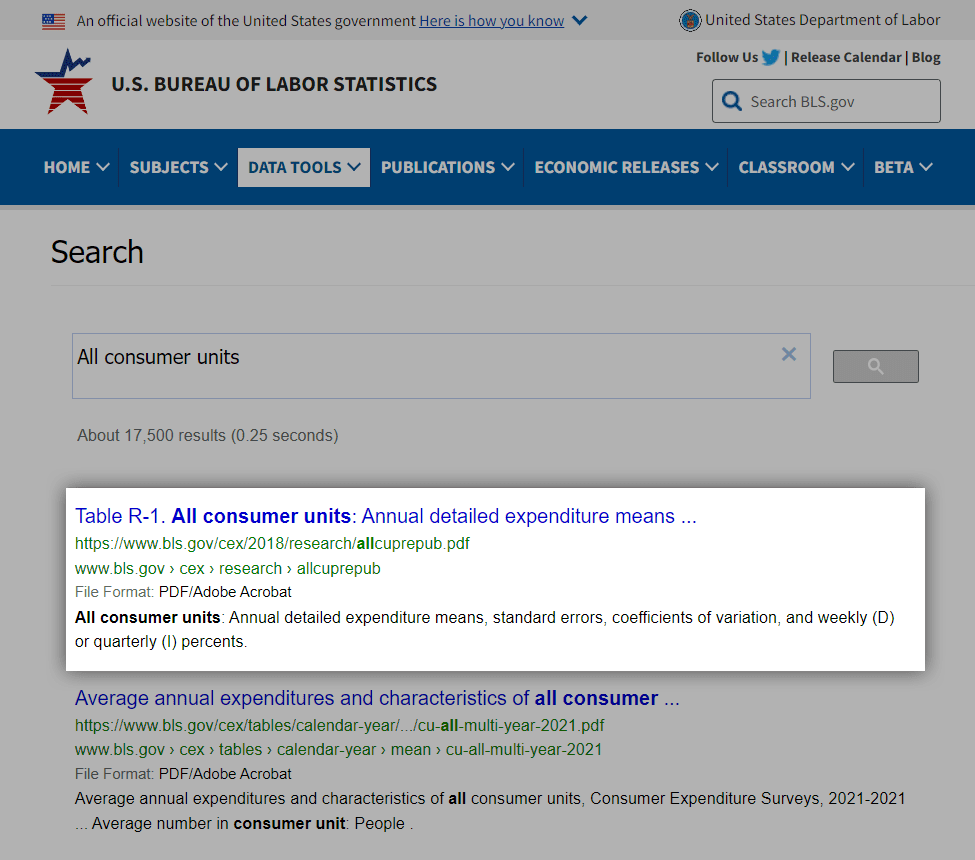
According to the Bureau of Labor Statistics, people frequently buy the following products, which means you should be able to sell them faster on a selling app or free online marketplace. You should make decent profits long term. The following shows averages of how families spend money each year:
Take a look at the list. It’s quite impressive.
The best items to flip online will depend on what site you are using. Mike told us:
You’ll find out about Amazon, eBay, Facebook, Poshmark, and Etsy in the following sections.

The best items to resell on Amazon include:
Buy in bulk and use Fulfillment by Amazon to qualify for Prime shipping for best results. Check out our interview with the owner of Shed Defender to find out how he makes $150K a month with Amazon FBA.
Next, we’ll answer “what are the best items to flip on eBay?”
If you’re looking for ebay flipping ideas, consider:
Those are the best things to buy and resell on eBay.
Mike also suggested broken old-school record players:
You can sell almost anything, but check their prohibited items policy if you still need to determine whether they will allow you to sell an item on eBay. We created an eBay walkthrough that shows you how to set up a shop and list your items. Next, we’ll discuss the best items to flip on Facebook Marketplace.
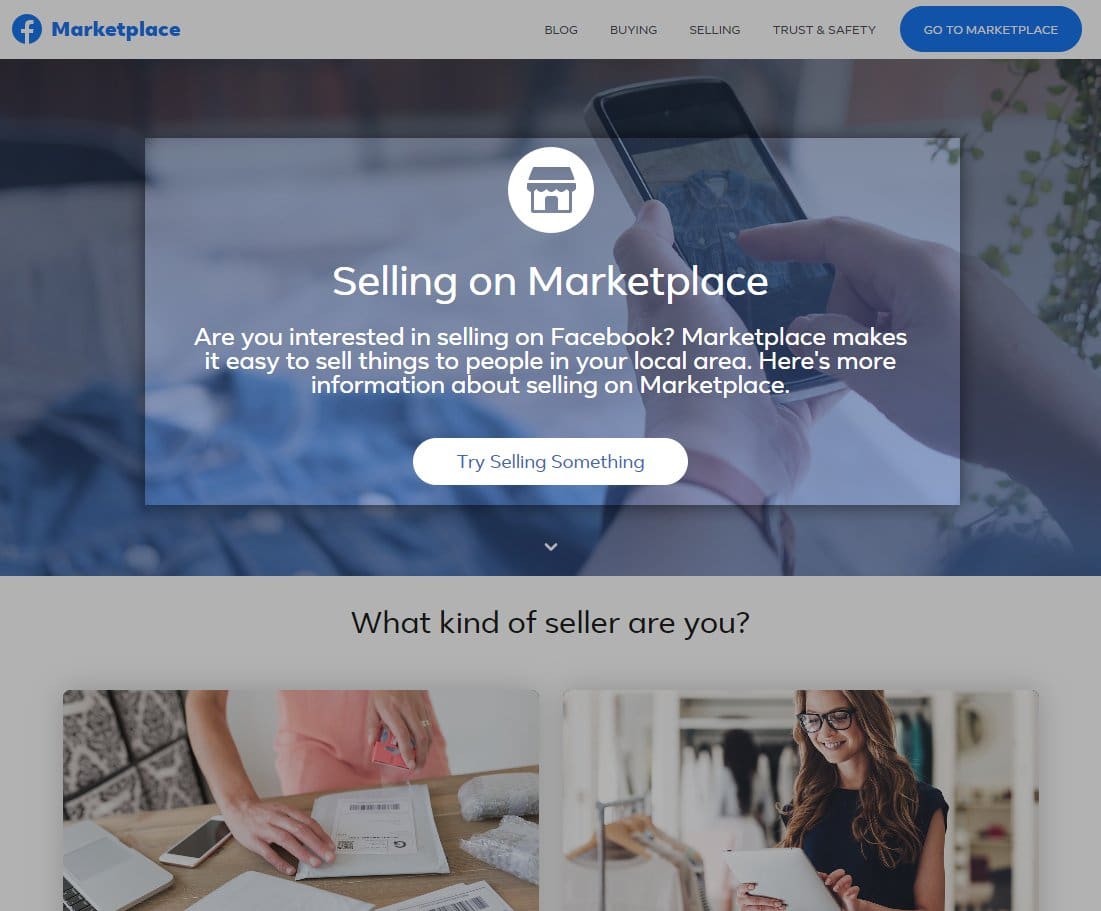
Facebook Marketplace is a great place to list items for local sales. The FB Marketplace helps people and businesses connect with buyers and sell their products. The Facebook Marketplace has the following categories:
They have a section for free items, too. Free items are probably the best items to resell because the profit potential can be astronomical. People give away furniture, TVs , food, monitors, and just about anything you can imagine. They expect you to pick it up, though. After you do, you can sell it elsewhere for market price. Learn more about Facebook Marketplace selling.
Check out this article for tools that get better results selling on Facebook.
Here are three types of auction flips that people normally search for:
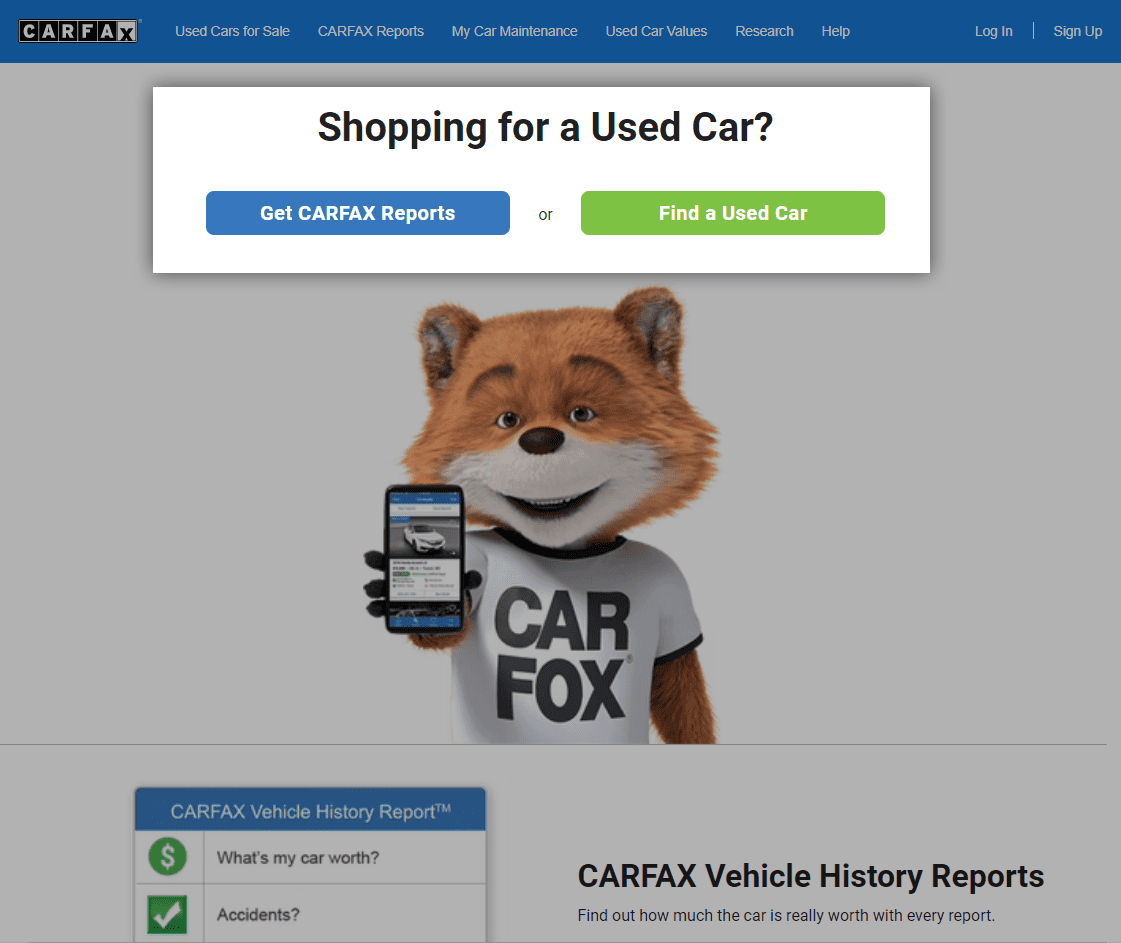
When you participate in auctions and then resell them on marketplaces, you will typically buy higher priced items like:
You probably won’t get much time to view them, so you need to be prepared. You can get deep discounts by buying property this way. I have seen homes sell for under 50% of market price.
Use CarFax or other VIN checkers if you are buying cars. It’s helpful to have someone working with you that is handy with mechanical work because you might have hidden repair costs that will slow down the selling process.
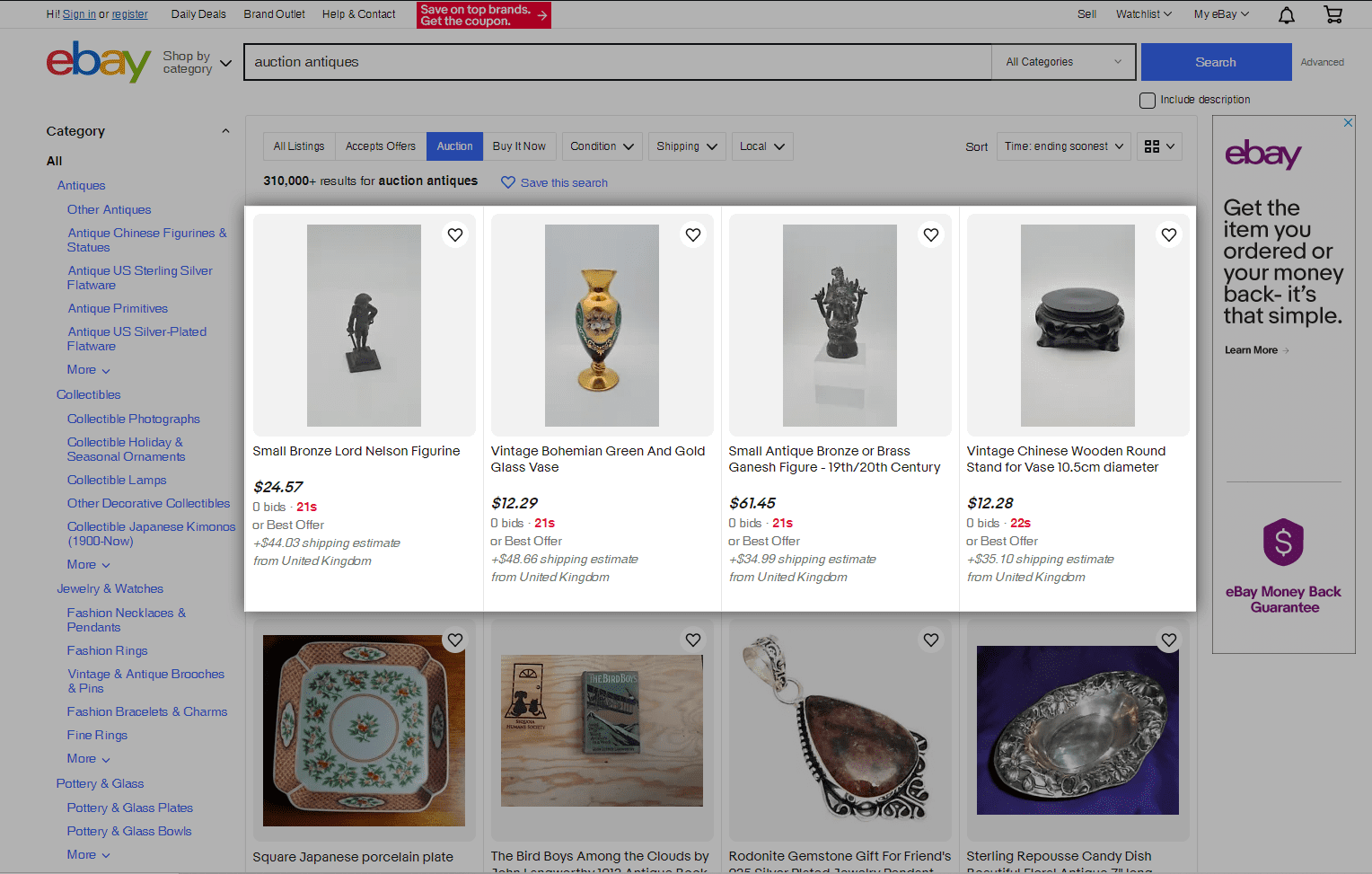
If you find something with a truly high resale value, sometimes the best way to sell it is at an auction. You can sell:
Every auction house takes a commission from the buyer, seller, or both. You can expect that the percentage will be at least 25% of the sales price, but potentially up to 50%. Auctions are best when you have an item you expect will be met with high demand.
Otherwise, every online marketplace charges less of a commission to resell for a profit.

Poshmark is a cross between social media and eCommerce where you can follow people on a secondhand apparel market and buy products from them. It’s better than leaving your stuff collecting dust. Ecommerce sellers and resellers can sell:
Turn your own collection into a full-time income by selling some of their most popular brands including:
Check out the Poshmark Guide for a few pointers on starting an online business.
Flipping products on Etsy requires sellers to offer vintage, custom, or digital products. If you are looking to resell on this online platform, consider:
Check out our blog about how to start an Etsy store or watch an interview with Vlad Kuksenko.
There are several places where people look for items they can resell. Some of the most common include:
Let’s look at how each works.
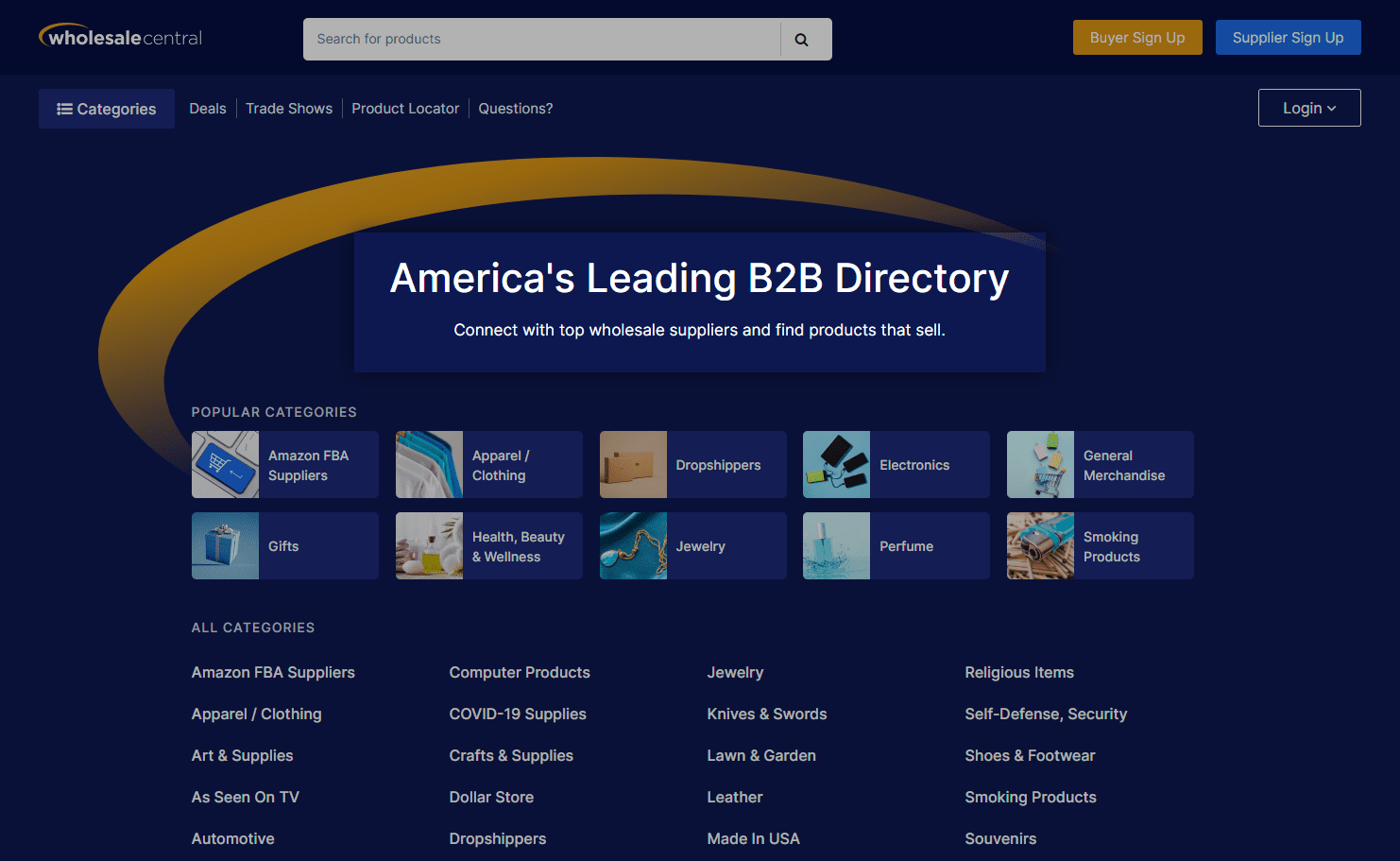
When you purchase items from a wholesaler, you buy in bulk for a discount. Then, you’ll sell each item individually. Your profit margin is based on the difference between the retail price and the per unit cost of your bulk order.
You can find a list of suppliers on Wholesale Central. You can also consider:
Many small business owners go to their local thrift store looking for items that they can sell for a higher price. When I worked at Goodwill in Austin, Texas, one of the regular customers found an item for $3 that he sold online for nearly $2,000.
Another place people like to go to find great deals are flea markets or swap meets. Sometimes seen as open-air events or large barn-style venues, these are places where lots of vendors go to buy, sell, and trade new and used items.

Yard sales and garage sales can be good ways to find items to resell. You’ll be able to find them on sites like:
These are similar to a garage sale but occur when entire properties need to be sold or managed efficiently. Sometimes families need or want to handle things as quickly as possible. Estate sales often help liquidate all belongings to pay for funeral costs or debts.
Mike told us:
You can find amazing deals at auctions. I bought two art deco nightstands used in a 5-star hotel for $10 one time. Check out Local Public Auctions for a list of auctioneers near you. If you find a real steal you can take them to one of the bigger auction sites like:
Mike warned that Storage Wars makes people think it’s easy but storage is a lot harder than it looks:

Online marketplaces are great places for good deals. Parents will often give away kids’ clothes, plus people sell furniture, power tools, and consumer electronics when they are trying to clear space in their homes.
Mike suggested checking out:
You might also try OfferUp, which bought letgo.com to offer both sites the same functionality.
If you are looking for commercial equipment, good deals on large amounts of products, and furniture for a restaurant or store, look for going out of business sales.
Sometimes companies will sell products for way less than normal, so they can clear space for new items. You can make serious money if you have a place to store them. For instance, after any major holiday, the pricing of seasonal items is discounted by up to 90%.
There are a ton of software programs that can help you find the best items to resell. Here’s a list of some of them and how they help you:
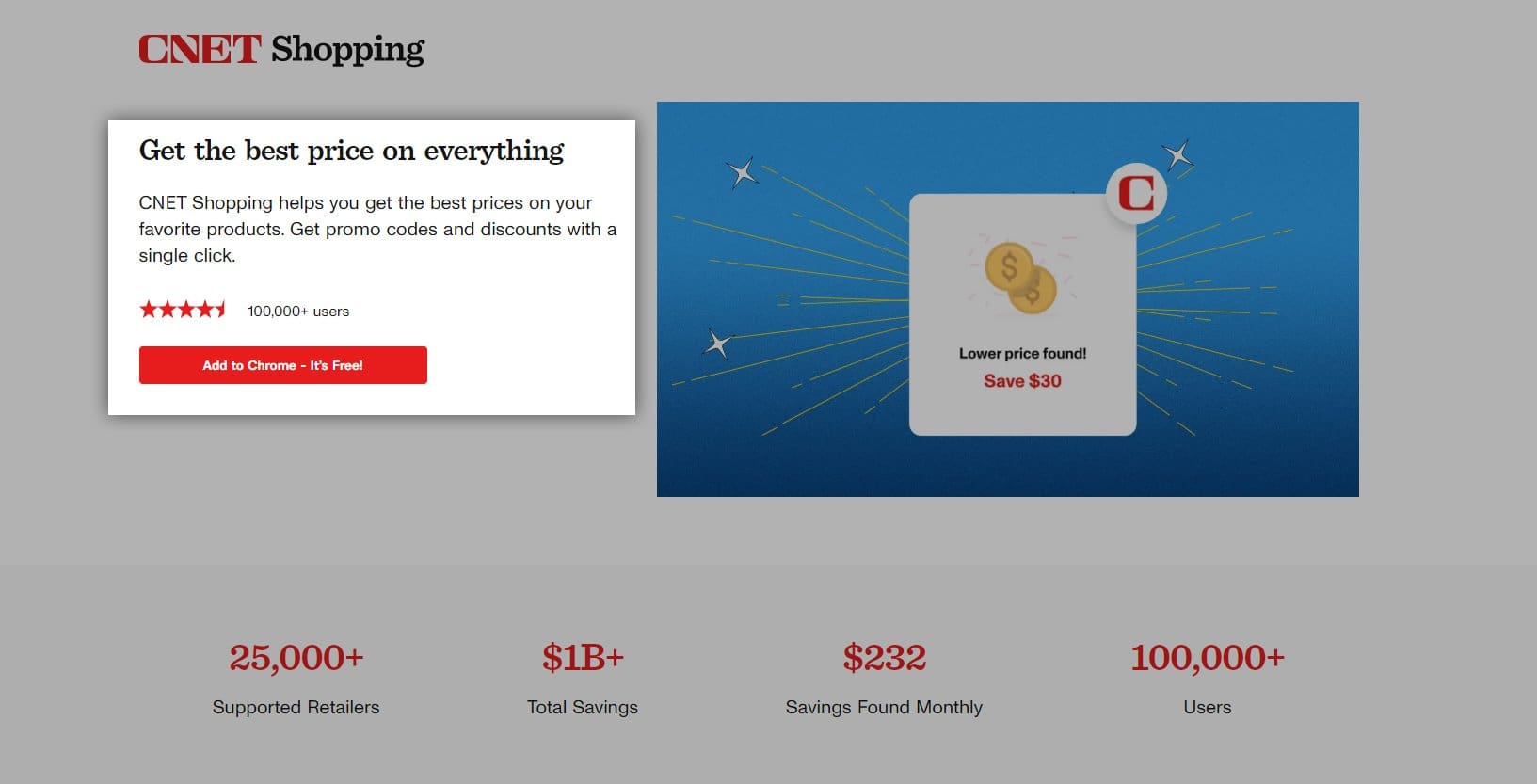
Formerly Invisible Hand, the CNET Shopping Chrome Extension will show you the lowest price to buy any product. It’s free, too. I found a couple of electronics with pricing of $100–$400 less than other sites.
Use Tactical Arbitrage to find products to buy on Amazon and flip on other sites. Look for wholesale products that will generate specific returns, or use reverse lookups to find the cheapest place to buy a product and resell it. You can combine all the features or get just the ones you need.
Get a RevSeller estimate of the profit you’ll make for selling products using Fulfillment by Amazon. It’s an extension that runs about $100, but it has a 30-day free trial.
Find profitable deals, buy them with SourceMogul, and have them sent directly to Amazon to sell.
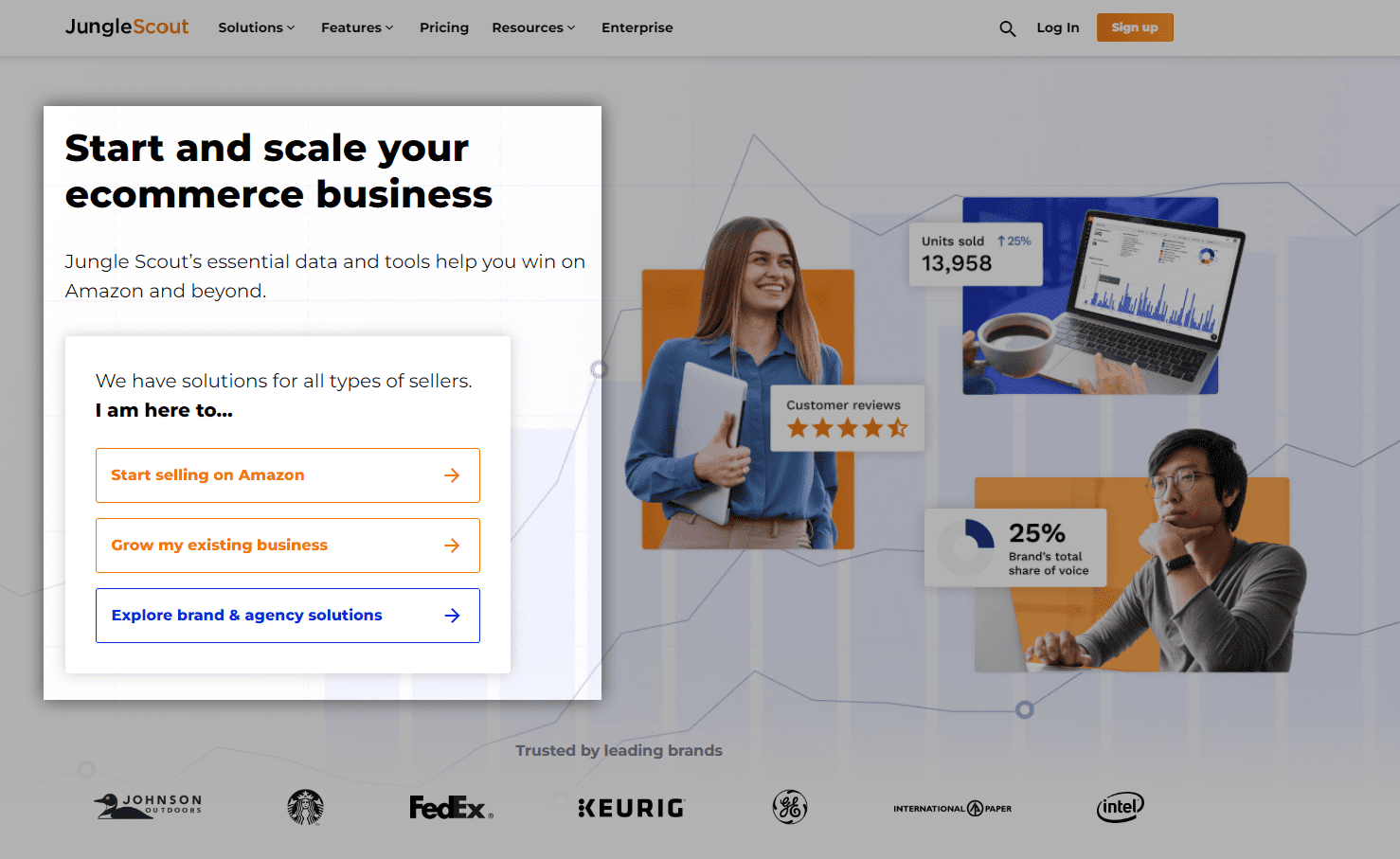
Find the best resale items with Jungle Scout. They rank items based on competition and where to purchase them. It even helps you track your Amazon seller ranking and find optimal keywords. They have a 7-day money-back guarantee, and packages start at about $30 per month.
Find sales in retail stores near you with BrickSeek. Just set custom notifications to find sales on products you can buy cheap and sell high.
Use your android phone to scan a barcode, check to see if it’s a good value, buy it, then list it on all of your platforms. It is also available for iOS. It seems to be a fairly new entrant that mostly operates using affiliate marketers, but the process seems to work.
Mike told us:
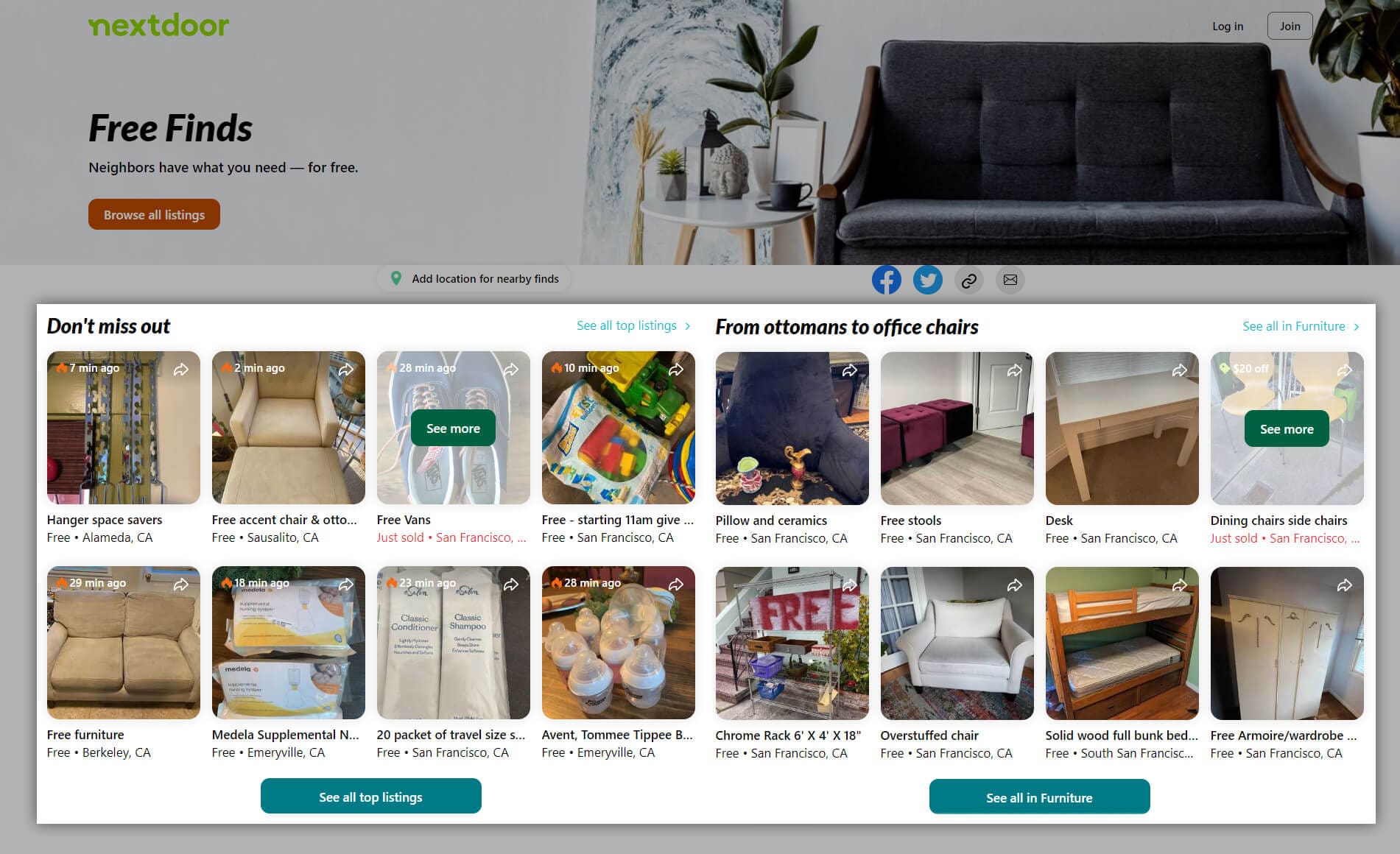
You’ll be surprised what you can find for free on Nextdoor Free Finds. Check out their listings of free items in your area.
There are a lot of opinions about what the best things to resell are, but from what I have seen, the following products tend to resell for far more than their normal purchase price:
Starbucks limited-time cups: The cups from Starbucks are hot sellers. They often go for three to five times the price Starbucks sells them.
Trending kids’ toys: Every year, you see people buy the hottest toys and mark them up to ridiculous values. This used to be just during the holidays, but TikTok has made it where people succeed in doing it year-round.
Vintage and Designer Clothing: Many donation stores misprice clothing because they don’t have the workforce to accurately price each piece of clothing. Sometimes you can find clothing and other products at ridiculous discounts and sell them online.
Designer Sneakers: Limited print shoes tend to be a profitable business. If you look at Jordan’s, they tend to sell on Amazon for up to $300 more than they cost when you could buy them in stores.learn how to become a shoe reseller.

People are always looking for good deals on items like:
If you’re looking for low volume and high profits, you’ll want to consider some of these items.
ASIC Miners: This is computer equipment used for mining cryptocurrencies like Bitcoin, Ethereum (soon to move away from mining), and Kadena. The pricing can fluctuate dramatically as shown in the chart below:
Cell Phones: When you upgrade a cell phone, the old one will often have a decent resale value if you don’t trade it in. This is especially true of the higher storage models, which are harder to find used.
Graphical Processor Units (GPUs): Crypto has dramatically impacted the value of GPUs. If you find computers with functional Nvidia GPUs in them, you may be able to sell them for a profit online. If you buy them now and hold them until the next bitcoin halving in 2024, you will likely see a lot of profit by flipping items.

Antiques: Many sellers hold garage sales and estate sales where you can find good quality wood furniture, antique toys, old books, and other products that may be worth serious cash. You have to know how to value them, but the profit potential is huge!
Vintage Cars: The 1968 Shelby GT had an original list price of $4,000-$5,000. Today people are selling restored vehicles for $150K+, nearly five to seven times what they would be worth when calculating for inflation.

Some items have really high demand like:
If you buy these in bulk and sell them individually, you can make a lot of money on the markup.
I’m not sure whether the above is saying is because people mispell “best” or because 32 million people love going to music festivals and some of us want to spend our whole lives at them (I’m in this category). I’m going to assume flipping items at music festivals is the intent.
If you’re looking for a great way to combine a love for tunes and making money, consider these fun items to sell:
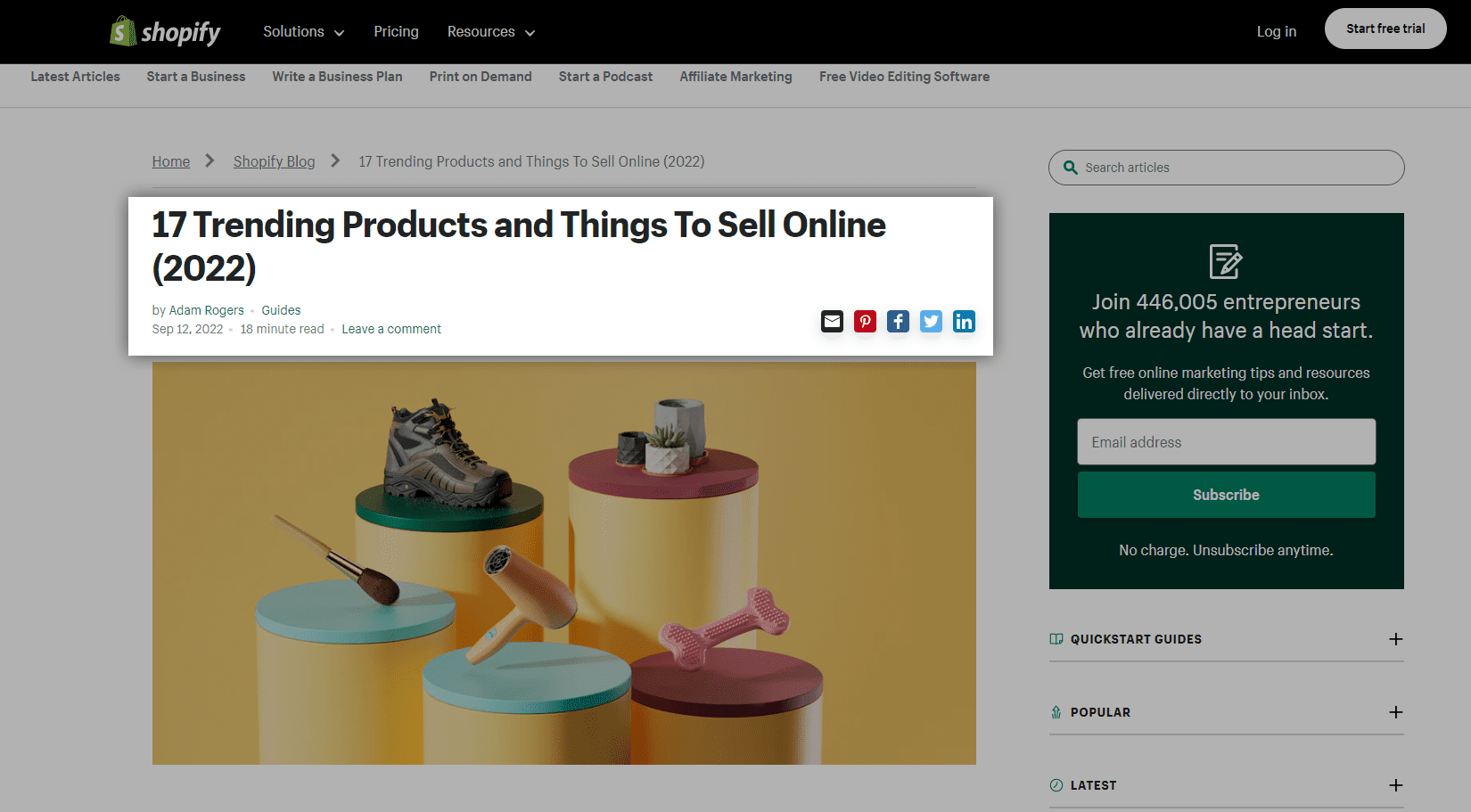
If you’re looking to flip electronics, you’ll want to know used and new market rates for each product. You’ll then want to find ways to buy the products where you can make a 33% gross profit margin.
If you’re trying to keep up with new electronic trends, use sites like:
Don’t forget to subtract your time, selling fees, and shipping costs from the price you want to sell the products. Otherwise you might pay too much.
There are a ton of things you can buy and resell for a profit. Some of the most profitable are:

This section is focused on video game items that you can earn and sell for a profit online. F2P stands for free to play. Many games allow you to create your own items and sell them in-game.
Other people build an account and sell it once they’re done with the game to recoup some of their costs. Be sure to read the terms of the game to make sure you aren’t violating their rules.
Some of the games that you can sell on are:
OldSchool RuneScape (OSRS): Original Runescape. The value of the items will be based on the rarity in the game, but the top ranked seller on PlayerAuctions has made over $15,000 selling over 100 items. A 3rd Age Pickaxe is listed for between $1,400 and $2,000. Not too bad for playing video games.
RuneScape: This is an updated version of OSRS. The resell values are lower.
Most Blockchain Based Games: Many of these will require an NFT, a metamask wallet, and a crypto debit card but you will be able to earn rewards that can be traded on the open market for cash. You can also sell your NFT if it appreciates in value.
Metaverse Worlds: Many metaverse companies allow selling online through their metaverse. Interact with people in VR and sell your real world items. Just don’t get stuck in the Matrix. You can also charge for access to your world and resell the NFT if you wish. Find the 10 best worlds to check out.
Bazaar Items: It appears this is referring to an online card game that is currently in beta testing. You can check out their website at Play Bazaar. It is a game created by the owner of the professional gaming team Tempo Storm. I’ll add the best items to Bazaar flip when the game releases to the public.
The higher price items that people flip on OSRS include:
PlayerAuctions has 200 other games you can sell items for including Roblox, World of Warcraft, Fortnite, and more.

For non-gamers RS is short for Runescape, which is another game with high demand items that people buy with real money using online sites. The rs best items to flip are:
Gold under $100 seems to be the best selling item, though. Prices are averaged from PlayerAuctions.
By far the best thing to resell for profit are homes and other real estate. For every $100,000 you spent on a home in 2012, you might have $132, 813 today. Plus, you can rent them out to cover the costs.
There’s a reason that the median household assets are dominated by their primary residence and rental properties. It’s because they have beaten inflation for the majority of the last century.
Check out our Podcast about how to invest in real estate.
Other assets that often increase in value include stocks and bonds.
For other items, you should probably consider using a formula similar to pawn shops. They assume they can sell it for the lowest price online or half the retail price, whichever is lower. Then they’ll offer you half of that.
So effectively use this process to find the price you are willing to pay:
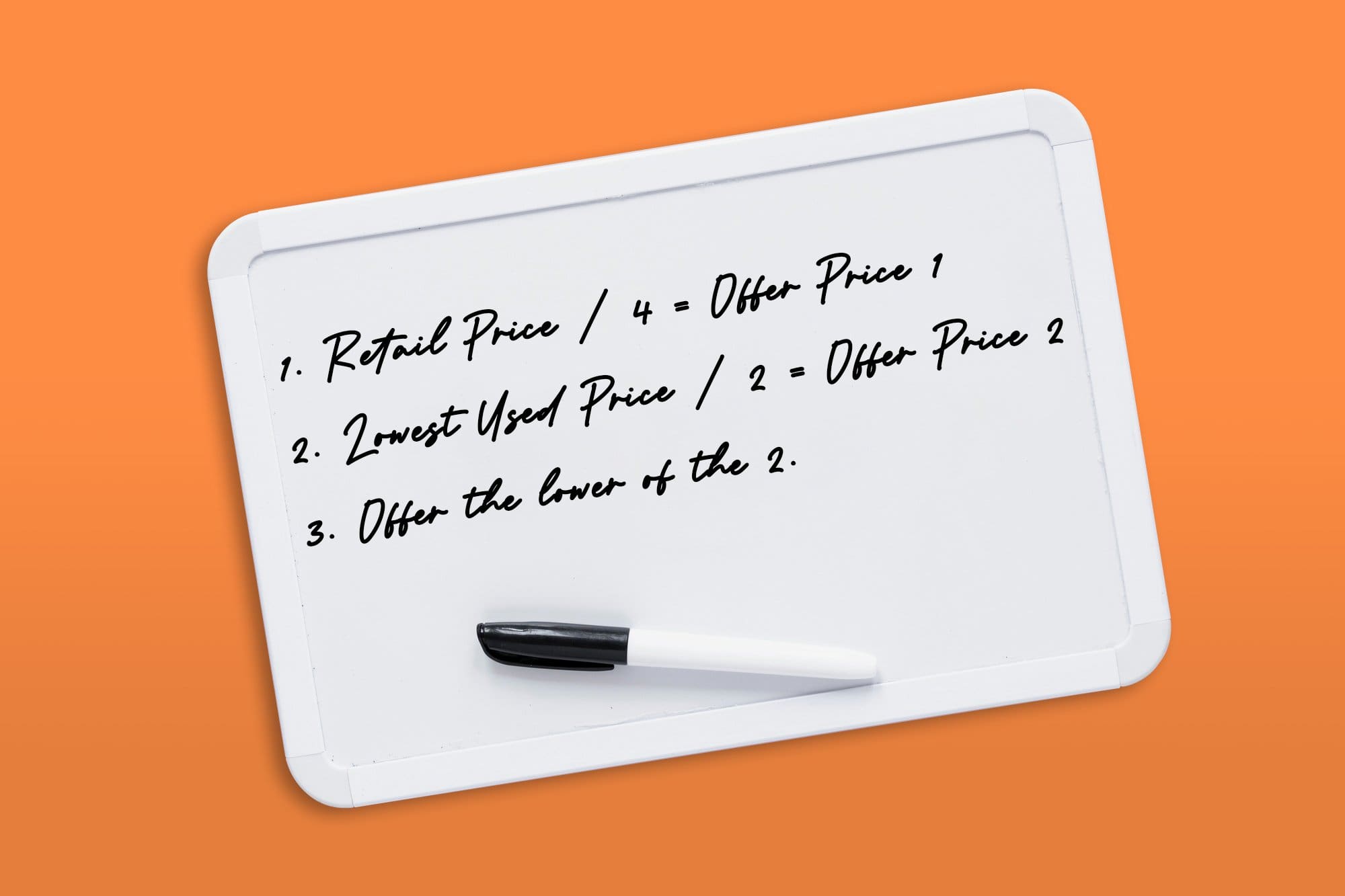
When researching the keywords for best things to buy and resell, this was surprisingly one of them. Sure you’ll save money by shoplifting, but money doesn’t do you much good if you end up in jail. Also, stealing causes inflation, which cause other problems.
But seriously, don’t commit crimes. It’s a horrible idea for advancing a business career.
Goodwill and other thrift shops are a great place to find items to sell. You will commonly be able to find the following items that are easy to sell:
You’ll need to enjoy what you are doing because you’ll spend a lot of time shopping for a deal you can sell for a higher price. If you love checking out thrift stores and yard sales, or doing online arbitrage, you might enjoy being a reseller. Learn how to resell.
What are your favorite items to resell?
Brandon Boushy
Want to go into 2024 with new business growth strategies to help you succeed?
We’ll discuss strategies that can help you improve your small business revenue and profit. We’ve taken advice from thousands of small business owners and provided seven actionable steps to grow your business before the year ends.
We’ll discuss why you need a business growth strategy, seven strategies to consider, how to implement the business growth strategies, and how to monitor the results of your business growth initiatives.
[su_note note_color="#dbeafc"]
By the end of this article, you’ll have the inspiration you need to make the most of Q4 and lead your business into the new year with confidence. Click on any of the links below to jump ahead.
Every small business should have strategies for business growth. As famed business coach Tony Robbins says, “If you are not growing, you are dying.”
Company growth strategies will help you create strategic growth opportunities.
The best growth strategies are the ones that expand your revenue with little to no increase in your marketing or sales budget besides a potentially one-time expense.

Business expansion requires a variety of strategies to both find new potential customers and build better relationships with existing customers. Top strategies that business owners suggest (and that we get behind enthusiastically) include:
All growth strategies should consider how you will implement automation within your business. Successful companies across every industry recommend using automation for repetitive tasks like emails, review requests, lead generation, and more.
With tools like ChatGPT and other AI software, automation will become an even bigger part of strategic growth initiatives.
Neel Parekh started MaidThis and explained how he used the automation growth strategy to help with market expansion that earns the remote cleaning business $1.5 million a year.
We use an automated five-step recruiting process. That includes:
Small things like including a person's name in an email, sending them a free gift during their birthday month, and other personalized marketing efforts can be automated and provide excellent growth marketing strategies.
Digital marketing offers so many tools for marketing growth strategies that there’s no reason not to include personalization in a marketing strategy. Check out HubSpot’s contextual marketing course to learn how personalized you can make your digital assets.
Craig Watson, the owner of Baked Cravings, explained the key to his growth strategy:
[su_quote]The key to growing [the business] is knowing exactly who you are marketing to.[/su_quote]
Learn more about Baked Cravings in this in-depth interview.
Another marketing growth strategy small businesses should consider is creating a loyalty program. One of the best ways to grow your business is to increase sales from your existing customer base.
KPMG found that seven factors impact customer loyalty the most. Your loyalty program can help with everything but product quality and consistency.
Consider using a loyalty program as an effective growth strategy for your products or services by offering
Check out Referral Rock for reviews of loyalty software to grow your business.
Mike Andes, founder of mega-successful Augusta Lawn Care, talks a lot about how to build your brand to build a loyal customer base. He used Starbucks as a growth strategy example:
[su_quote]Your brand has to constantly evolve, or it dies. If you look at Starbucks, they change all kinds of things: subscriptions, loyalty programs, social initiatives, and other things. All that’s branding.[/su_quote]
Hear more from Mike below.
Another way to grow your business is to stop wasting money on products or services that aren’t helping you in the existing market. This frees up money for you to spend on your growth strategies, existing products, or services that your target market wants.
You can apply this strategy by looking at keywords with high cost-per-click and low conversion rates and removing them from paid ad campaigns. You might also want to remove products that have been on the shelf for a long time from your inventory.
Afshan Abbas explained
[su_quote]When you’re starting a shoe company, figure out what your niche in that shoe business would be because it’s a very crowded market. And if you are going to do something that other people are doing, it will be a really hard sell.[/su_quote]
Another growth strategy that can work remarkably well is notifying customers about upcoming price increases to existing products or services.
Given many small businesses raise their prices near the beginning of the year, you can encourage people to book and pay for your services (or purchase products) before the price change so they get the current pricing.
Your customers save money, and it helps you meet your goals in your business growth plan. Best of all, this business growth strategy costs you barely anything.
Big Frog franchise owner Sanford Booth uses a similar growth strategy when he hits slow times:
[su_quote]When I hit slow times, I reach out to previous customers and see if they need anything. The follow-up will often help me make it through tougher times.[/su_quote]
Check out our interview with him below.
As you enter the fall and winter months, you can use discounts as a growth strategy. Help your business grow by increasing sales during commonly slower months. This is especially effective if you own a service business that can offer to help with the challenges people face when they have family come into town.
You might also tap into untapped markets. For instance, Jackson Blackburn runs a window-washing business that makes around $100K monthly. He offers Christmas light installation during the winter months to level out some of the seasonal fluctuations.
Check out our interview with him below.
Business owners want sustainable growth consistently, but sometimes, they forget that a crucial part of the business growth is the employees who work with them.
Whether you are a solopreneur or leading a small business that has sustained growth for decades, take the time to celebrate when you meet growth strategy goals, complete a project, or someone has a memorable life event.
A great company culture will refresh you and prepare you to concur new markets or goals. Mike Andes experienced this as he pursued his market expansion strategy and sold more than lawn care franchises. He told us:
[su_quote]When a business grows too fast, it becomes a mess; you’re always playing catch up, you are bringing on more people, and it can cause chaos. This is typically the time when owners give up on small businesses.[/su_quote]
Take the time to celebrate wins before taking on the next leg of your market expansion goals.
We have some fantastic editors at UpFlip who sometimes share their stories about small businesses and strategies that inspire them. Forest & Meadow, an herbal shop, shared the post below to celebrate their team—and it got our editor thinking about which Forest & Meadow teas and tinctures she might want to buy now that it’s getting cold outside.

To create a successful growth strategy, you’ll need to:
One of the best ways to start working on a growth strategy is to download a template to help you get started. Download our growth strategy plan template.

In this section, you’ll explain the growth strategy you are trying to achieve. Some standard growth strategies include:
A market expansion strategy focuses on entering a new geographic market once you can no longer increase your market presence in your current market. You might also hear this called market development or a market penetration strategy.
This strategy must consider new regulations, cultural differences in the new market, and how currency conversion might impact your company.
Achieving a market penetration strategy will also require comparing the demand and benefits of entering potential markets to decide which new market is right for your company.

Companies form strategic partnerships in numerous ways to increase business growth. They might form a partnership to enter new markets using each other's distribution channels, or they might share valuable insights, internal resources, and technology for new product development.
When a company’s existing products are not creating revenue growth, it might choose to start product development to expand its product line. Using product expansion helps you increase revenue by providing new products to both new and existing customers.
This product-led growth may be costly, depending on the industry. Increasing a product line can cost thousands to millions of dollars through the product development process.
While product expansion can increase returns, you should conduct market research to verify that the current market needs the new product. Otherwise, a significant investment in research and development (R&D) may fail to create the product-led growth you’re after.

Acquiring assets can be a successful form of business growth. You see growth strategy examples using the mergers and acquisitions (M&A) business model in most major corporations.
The higher cost of capital has slowed some growth in business mergers, but industries like healthcare, materials, and energy are still seeing significant market consolidation.
When you buy a company, you get its existing market share, its customers, and industry research, and you may be able to save money by consolidating systems and positions.
This strategy can be a great way of increasing your market share in the same market or entering a new market. You’ll be able to pursue new customer segments, reduce customer acquisition costs, and increase your company’s market share.
That doesn’t mean this strategy is without its problems. While there are plenty of growth examples, everything from paying too much for a company to a lack of synergy and poorly integrating the two companies are risks of an acquisition growth business.
Another market growth example is diversifying to increase your total addressable market. There are four primary ways to diversify:

You’ll want to research how other businesses in your industry are approaching growth, what customers want, and what software and tools are available to pursue your growth strategy.
Pro Tip: Learn more about performing market research.
Whichever growth strategy you use, you’ll need to define your goals, the metrics you’ll use, and the level of improvement you’ll need to see to call the strategy a success. We discuss more about key performance indicators in our one-page business plan.
At this point in the process, you need to detail the exact approach you’ll use to accomplish your growth strategy. You’ll want to define the tasks, time, resources, and parties involved to achieve the market development strategy you’re going to try.
The more detailed you can be in this step, the better. You’ll have a resource for keeping yourself on track and helping others picture how the process will work.

Once you’ve created the plan, it’s time to gather everything and everyone you need to accomplish the task. You might need Zoom or Google Meets communication tools if you are working with remote teams. If you aren’t using one yet, you may want to invest in a CMS for small business, too.
Pro Tip: Make sure to get multiple bids if you are using external service providers.
The final step is executing the growth strategy and measuring its market penetration. Whether you’re lowering prices or using increased paid advertising, you’ll want to make sure that your business growth strategy is meeting your goals and adjust as you go.
Next, we’ll discuss ways to measure your business growth strategy to understand if it is successful.

You’ll need to measure the success of your business growth strategies, and there are numerous ways to measure the growth. Some common ways to measure the success of business growth include:
One of the reasons we love what we do is that we get to learn from hundreds of brilliant and successful people. We have a feeling that’s why you keep coming back, too.
We love hearing about other people succeeding. Share your stories in the comments below. What business growth strategies have you tried, and how did they turn out?
Get ready for the most boring blog you’ve ever read! In just a few minutes’ time, you’ll know a lot more about 17 boring businesses that could bring in serious revenue.
In this post, we’ll discuss an array of boring business ideas and explain how to start or buy them. We’ll also provide some general tips on what to look for when investing in boring businesses.
By the time you finish reading, you’ll know which boring business is right for you, and how to make it profitable.
[su_note note_color="#dbeafc"]
Click on any of the boring links below for more information on the “boring business” model, or just continue reading.

The term “boring business” has become popular because of Codie Sanchez, the owner of the business education service Contrarian Thinking. A major part of her wealth-building strategy is buying boring businesses.
A boring business is defined by four characteristics. It is:
You might hear this boring business framework called SOWS for short.
The industries in this list aren’t the sexiest, but they offer essential services and make a steady income with recurring revenue. Steady income means there aren’t huge fluctuations in cash flow; recurring revenue is achieved by having customers return regularly.
Many have low startup costs and can serve as passive income streams.
The boring business ideas below can help you hit the ground running as a business owner.
Keep reading to get the low-down on each boring business.

• Average Annual Revenue: $311,220
• Average Profit Margins: 22.10%
• Startup Cost: $100K-$3.5M
• Time to Revenue: 6-18 months
• Annual Market Growth Rate: -0.1%
• Best For: Customer service pros with high attention to detail
Laundromats have recurring revenue and provide a valuable service for the 16% of American households that do not have washers and dryers in their homes.
These small businesses provide a steady income because Americans do an average of eight loads of laundry per week, and laundromats charge $2 to $4 per load.
Laundromats in zip codes below the poverty line will normally have the most profit potential. Cities like New York City, Chicago, and Los Angeles have higher percentages of people without laundry machines in their homes.
• Average Annual Revenue: $73,100
• Average Profit Margins: 16.10%
• Startup Cost: $500+
• Time to Revenue: 3+ months
• Annual Market Growth Rate: 1%
• Best For: Car enthusiasts and detail-oriented entrepreneurs
A car wash is another boring business with heavy cash flow.
With a quick online search, you can find lots of car washes for sale. Sometimes, you can find them for as low as the cost of the land. From there, you can increase cash flow with simple fixes like adding automation, cashless payments, or even leasing extra space to other businesses.
You’ll also be able to use the land to secure capital through small business loans and grow your business empire faster.

• Average Annual Revenue: $182,100
• Average Profit Margins: 4.30%
• Startup Cost: $2K-$10K
• Time to Revenue: 3+ months
• Annual Market Growth Rate: 0.5%
• Best For: Organized entrepreneurs who like driving, people who want a semi-passive business
Automated vending appears to have a small growth rate and average profit margins. Meanwhile, it’s one of those business opportunities that combines low startup costs and good cash flow, and it gets more profitable as you add more machines to a route.
Just ask vending machine business owner Adam Hill, who makes $700K per year working just two days per week.
Did you enjoy the video? Check out our vending machine business course.
• Average Annual Revenue: $182,100
• Average Profit Margins: 4.30%
• Startup Cost: $2K-$10K
• Time to Revenue: 3+ months
• Annual Market Growth Rate: 0.50%
• Best For: Organized entrepreneurs who like driving, people who want a semi-passive business
Another boring business you can start is placing ATMs in other small businesses. Many businesses need ATMs but don’t want to manage them. You’ll make $2 to $5 per transaction, and potentially even more in high-demand areas, like Vegas casinos.
You can manage the services or turn the revenue into 100% passive income by using services like ATM Together, which help (or completely) set up your business.
There are even specialized ATMs like Bitcoin ATMs or Coinstar.
• Average Annual Revenue: $621,212
• Average Profit Margins: Varies by industry
• Startup Cost: $1K-$3.5M
• Time to Revenue: 3-18 months
• Annual Market Growth Rate: Varies by industry
• Best For: People who want to skip the trial-and-error phase of small businesses
Companies in several industries offer franchising opportunities, making it easy to start making money as a business owner.
Over 10% of companies are a franchise, and franchises account for 3% of GDP. The McDonald’s down the street, for instance, is likely a franchise, meaning it’s owned and run by an independent franchisee with the company’s permission.
Franchises are boring businesses because the business model's success has already been proven and you can use existing intellectual property and processes in day-to-day operations to make a great living.
If you’re ready to buy a small business, check out our blog on the best franchises to own.
• Average Annual Revenue: $27,375 per home
• Average Profit Margins: -11% to +10%
• Startup Cost: $60K+
• Time to Revenue: 3-12 months
• Annual Market Growth Rate: Fluctuates with tourism and value compared to hotels
• Best For: Recognized real estate professionals or service business owners
Real estate ownership is the number one driver of wealth for most American households. In fact, second homes contribute to wealth creation in 4% to 6% of the population. That makes rental properties a great way to earn more money and develop a steady stream of recurring revenue.
Two particularly successful rental property management strategies include opening Airbnb rentals and buying and leasing quadplexes.
Find out how to turn real estate rentals into a $3M per year business below:
• Average Annual Revenue: $204,700
• Average Profit Margins: 5.40%
• Startup Cost: $500-$5K
• Time to Revenue: 3+ months
• Annual Market Growth Rate: 0.7%
• Best For: Construction and repair pros, creative problem solvers, outgoing and hands-on entrepreneurs
Providing home maintenance can be a very consistent way to earn money because you’re providing an essential service. It’s also one of the few small businesses in the construction industry that doesn’t require a contractor's license.
Learn how to start a home maintenance service company from a handyman making $250K per year with just two trucks.
• Average Annual Revenue: $1.94M
• Average Profit Margins: .9%
• Startup Cost: $100-$5K
• Time to Revenue: 1-3 months
• Annual Market Growth Rate: -2.3%
• Best For: SEO experts and people who are great at finding low-competition keywords
The office supply industry can be risky to invest money in because there is declining demand for many of the products they offer. But there are plenty of ways to get customers, especially if you run an online business.
You can make a steady stream from eCommerce if you offer business supplies with a dropshipping business model. If you have a physical location, you can include services-based offerings, like graphic design, printing, and shipping.
• Average Annual Revenue: $1.57M
• Average Profit Margins: 18%
• Startup Cost: $500-$5K
• Time to Revenue: 1-3 months (not including time training as a CPA)
• Annual Market Growth Rate: 1.7%
• Best For: CPAs, finance experts, entrepreneurs with strong math skills
One of the most boring businesses you can conceive of is an accounting or bookkeeping business.
There’s a high demand for these services because 33 million small businesses and 124 million U.S. households need tax advice and other services. You can increase your success by specializing in niche areas, like eCommerce accounting.
Of course, accountants and bookkeepers require specialized education.
• Average Annual Revenue: $135,882
• Average Profit Margins: 66.5%
• Startup Cost: $100K-$10 million
• Time to Revenue: 6-18 months
• Annual Market Growth Rate: -1.8%
• Best For: Commercial landowners, remote workers, and people who like having spare time during their day job
When you invest in storage space, most of the cost will be the purchase of the building and any upgrades you do. Many businesses in this industry can be turned into almost entirely passive income sources by adding keypads, automated locks, and online booking.
• Average Annual Revenue: $272,790
• Average Profit Margins: 8.7%
• Startup Cost: $1K-$100K
• Time to Revenue: 1-3 months
• Annual Market Growth Rate: 8.1%
• Best For: Gardeners, landscape designers, people who love hands-on, outdoor work
There’s constant demand in this growing market, and there’s also great opportunity.
Most landscaping companies lose 8% to 10% of their customers each year, and their biggest challenge is when people aren’t happy with their services. That makes the industry ripe for businesses that focus on offering clients great customer service. If you can automate the business processes, your revenue could increase even more.
Mike Andes started in landscaping services when he was just a teenager, and today, he’s sold over 133 Augusta Lawn Care Services franchises and has expanded into real estate. Check out our playlist of interviews with Mike Andes below:
• Average Annual Revenue: $755,180 ($62K for solo)
• Average Profit Margins: 10.8%
• Startup Cost: $1K+
• Time to Revenue: 1-18 months
• Annual Market Growth Rate: 5.1%
• Best For: Friendly professionals with an attention to detail
This boring business idea is in high demand. You can clean homes on a one-time or routine basis, and people pay good money for it.
Before you invest in a cleaning business, review our resources for cleaning businesses that we created with Chris Mondragon. He’s a featured speaker at housecleaning conventions and runs a multi-million-dollar house and Airbnb cleaning service.
We even have a cleaning business course that promises to help you earn $10K and comes with a 90-day refund policy.
• Average Annual Revenue: $1.47M
• Average Profit Margins: 5% to 10%
• Startup Cost: $100K-$3.5M
• Time to Revenue: 6-18 months
• Annual Market Growth Rate: 4.3%
• Best For: Landowners in high-traffic areas
Owning parking lots is perfect for people who want to run an automated business or sit outside all day at work.
Many businesses in this industry have lots of land in high-demand areas, like downtown in major cities. They charge by the hour and make money accepting cash and credit cards, so no one is required to be on site.
Parking lot owners commonly have relationships with the local government so law enforcement tickets people who don’t pay to use their parking spaces.
• Average Annual Revenue: $265,808
• Average Profit Margins: 22.10%
• Startup Cost: $100K-$3.M
• Time to Revenue: 6-18 months
• Annual Market Growth Rate: -6.7%
• Best For: Customer service pros with high attention to detail
Dry cleaning can be decent money, but the industry is in decline with the rise of work-from-home jobs. That just means you have opportunities to buy businesses at a discount.
Many of the dry cleaners for sale online are asking for less than two times the annual cash flow. If you buy them using seller financing with 20% of the money down, you could buy a dry cleaner for as little as $20K now and pay it off over time.
For more on seller financing, check out our guide to buying businesses with little to no money.
You may have difficulty getting loans from traditional lenders when considering this investment because of the industry decline.
• Average Annual Revenue: $25.4M
• Average Profit Margins:1%-10%
• Startup Cost: $1K+
• Time to Revenue: 1-18 months
• Annual Market Growth Rate: 7%
• Best For: People who love cooking
Providing customers with pre-proportioned meals is boring because it consists of primarily repetitive tasks and has a low profit margin.
A small business in this industry makes money by cooking food in bulk and breaking it into individual meals. Its clients are mostly busy professionals who want to eat healthier and don’t have time to do their own meal prep.
People can pay by the meal and may get a discount if they return the reusable packaging.
• Average Annual Revenue: $73,533
• Average Profit Margins: 11.5%
• Startup Cost: $1K-$100K
• Time to Revenue: 3+ months
• Annual Market Growth Rate: 1.1%
• Best For: Pet lovers and experts, salon and grooming professionals, empathetic and detail-oriented entrepreneurs with strong customer service skills
Pet sitting and grooming companies are boring business ideas that can make decent profits. They aren’t high-growth and are labor-intensive, but you get to play with cute dogs and kitties.
Martin Burt and his wife explain how to start a pet sitting business in our definitive guide. We have information on pet boarding, too.
• Average Annual Revenue: $8.72M
• Average Profit Margins: 7.29%
• Startup Cost: $1K+
• Time to Revenue: 3-18 months
• Annual Market Growth Rate: 1.9%
• Best For: Customer service pros with high attention to detail
Waste management companies remove junk from sites and take it to the dump. Society’s reliance on them is here to stay.
When you buy a waste removal business, you’ll want one with employees already if you’d like it to be a passive income source. Otherwise, you’ll have to work in the business until the hiring systems, insurance, and payroll are in place.
Learn how Kyle Landwehr started his junk hauling business and turned it into a $3 million per year business.
Next, let’s look at how to buy a business with little money and convert it into a steady stream of revenue.
You can buy many small businesses with less capital than it takes to start a new business, but you’ll need to go through a defined process before you invest. We suggest the following process for buying businesses:
You’ll specifically want to master securing seller financing to achieve the most success when pursuing boring businesses for sale. Again, you can learn about the process in our blog about how to buy a business without money.
Now let’s look at a list of property management businesses that can help you make a great living.
Real estate and property management businesses are boring businesses that lots of people look to for investment opportunities. Whether you’re just getting started in the real estate investment world or have years in the space, you can make a great living.
You’ll earn cash flow, at least, but you may also earn additional funds from appreciation of assets when you sell them. Check out the list of real estate businesses I love:
The best thing about these boring businesses is you can manage your entire investment portfolio from a single platform and website, which makes it easier to manage multiple businesses as the demand grows.
Want more bloody boring business ideas?
Check out the list of 99 more boring businesses below!
| Awning installation | Garage door service/installation | On-demand cleanup crews | Surfboard and equipment rentals |
| Biking tours | General contractor | On-demand holiday decorations | Surveying |
| Boat repair and maintenance | Gutter cleaning | Online communities | Tree removal |
| Camping sites | Hiking tours | Outsourced customer service | Tree trimming |
| Carpentry | Home garage buildout | Painting | Trucking |
| Carpet cleaning and steaming | Home inspection/thermal imaging for utility analysis | Party rentals | Logistics |
| Carpet, tile, and flooring installation | Home office buildout | Pest control | Used car lots |
| Catering | House painting | Pet grooming | Videography |
| Commercial cleaning | House staging | Photobooth, snapshot, and accessory rental | Warehouse storage rack installation |
| Commercial power washing and striping | Hunting guides | Photography | Welding |
| Concrete | HVAC installation and cleaning | Pipefitting | Window cleaning |
| Custom wallpaper installation | Insulation installation (spray and standard) | Plumbing | Yard contracting, designing |
| Deckbuilding and staining | Interior design | Podcast production | |
| Door/window installation | Irrigation system installation | Pool/hot tub services | |
| Dumpster rentals | Laundry services | Porta-potty rentals | |
| Electrical | Lighting services | Property manager | |
| Elevator installation and service | Liquidation services | Realtor | |
| Epoxy flooring | Liquor store | Roofing | |
| Epoxy business | Loan officer | RV parks | |
| Equipment operation | Machine servicing | RV services | |
| Equipment rental | Masonry | Scaffolding | |
| Event DJ | Mini-mailbox centers | Septic service/pumping | |
| Event management | Mobile glass repair | Septic tank installation and service | |
| Excavation | Mobile home Parks | Siding | |
| Farmland | Mobile tire sales/service | Sneaker resale | |
| Fence installation | Mold, fire, and water damage remediation | Solar panel installation | |
| Fire sprinkler system installer/detector installation | Moving services | Specialty food trucks | |
| Food tours | Niche class-based gyms | Mobile wine business | |
| Foundation repair | Oil-change centers | Supercar rental |
Now you have plenty of boring businesses to consider buying or starting up. They span several industries and skill sets. You might want to start with a business that costs less and build up to more expensive ones as you develop wealth.
The Boring Company is the most boring business in all the world. Seriously!
Maybe not the take on “boring” you expected, but Elon Musk started The Boring Company because he was tired of dealing with traffic.
The Boring Company uses boring machines called Prufrocks to bore tunnels at a rate of one mile per week, but they aim to eventually bore seven times faster than that. The tunnels are used to transport passengers around the Las Vegas Convention Center and to Resorts World in Tesla vehicles. There are other tunnels in the works.
The world is full of opportunities with lots of demand and not a lot of competition. It’s up to you to find the boring businesses that work for your portfolio.
What boring businesses do you find the most appealing for your investment strategy?
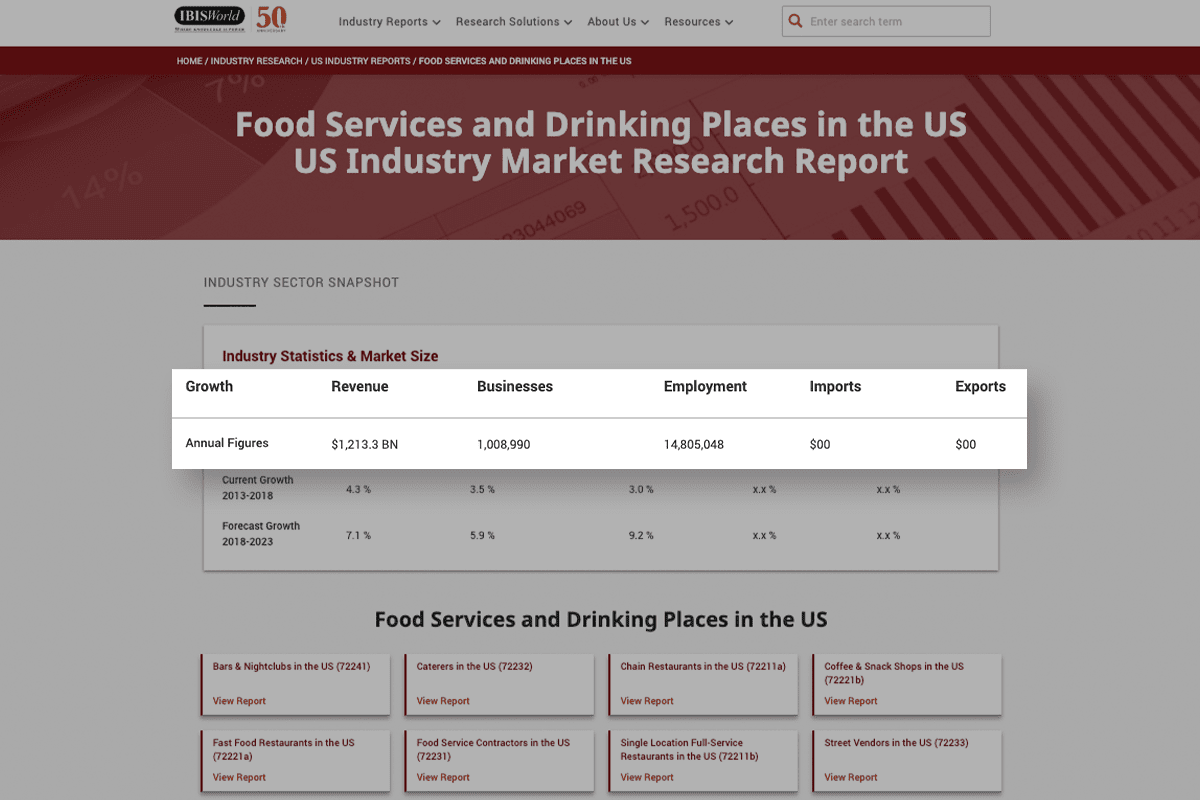 According to IBIS World, the food service industry makes over $1.12 trillion across over 1 million businesses. There are 135 reports that come up covering restaurants from pizza places to italian, franchise, fast food, or single-location full-service restaurants.
For the purpose of this article, we’ll use report 72211b: Single Location Full-Service Restaurants in the US. I strongly advise you review their full list of restaurant reports to see if there is one that is more relevant to you.
This group of restaurants includes:
“single-location, independent or family-operated restaurants that provide food services to patrons who order and are served while seated (i.e. waiter and waitress service) and pay after eating. These businesses may sell alcohol and other beverages in addition to providing food services to guests.”
These single-location restaurants make up nearly 16% of the 1 million restaurants, 18.6% of the food service revenue, but only 4% of the industry profit. This makes it a lower profit than chains, bars, and fast food restaurants.
Such revenue is expected to grow from $208.9 billion in 2023 to 211.2 billion in 2028. Those in the fine dining field are seeing the most success because high-income earners are less impacted by price changes. I would describe Huber’s pricing as being on the low end of the fine dining spectrum.
Adam told us:
[su_quote]You need top quality products and low turnover. It’s the only way to maintain quality.[/su_quote]
He went on to describe the current environment.
[su_quote]We had to raise prices because of the current economic environment, rising food costs, and challenges finding employees.[/su_quote]
He also warned about the challenges of restaurant startup costs.
[su_quote]One of the biggest issues with a new business or new restaurant is having enough financing.[/su_quote]
According to IBIS World, the food service industry makes over $1.12 trillion across over 1 million businesses. There are 135 reports that come up covering restaurants from pizza places to italian, franchise, fast food, or single-location full-service restaurants.
For the purpose of this article, we’ll use report 72211b: Single Location Full-Service Restaurants in the US. I strongly advise you review their full list of restaurant reports to see if there is one that is more relevant to you.
This group of restaurants includes:
“single-location, independent or family-operated restaurants that provide food services to patrons who order and are served while seated (i.e. waiter and waitress service) and pay after eating. These businesses may sell alcohol and other beverages in addition to providing food services to guests.”
These single-location restaurants make up nearly 16% of the 1 million restaurants, 18.6% of the food service revenue, but only 4% of the industry profit. This makes it a lower profit than chains, bars, and fast food restaurants.
Such revenue is expected to grow from $208.9 billion in 2023 to 211.2 billion in 2028. Those in the fine dining field are seeing the most success because high-income earners are less impacted by price changes. I would describe Huber’s pricing as being on the low end of the fine dining spectrum.
Adam told us:
[su_quote]You need top quality products and low turnover. It’s the only way to maintain quality.[/su_quote]
He went on to describe the current environment.
[su_quote]We had to raise prices because of the current economic environment, rising food costs, and challenges finding employees.[/su_quote]
He also warned about the challenges of restaurant startup costs.
[su_quote]One of the biggest issues with a new business or new restaurant is having enough financing.[/su_quote]
 In this step to open a restaurant, you’ll want to identify your target customers. Try to understand what kind of prospective customers visit the style restaurant you are opening. Some of the information you’ll want includes:
In this step to open a restaurant, you’ll want to identify your target customers. Try to understand what kind of prospective customers visit the style restaurant you are opening. Some of the information you’ll want includes:
| $500K Annual Revenue | $1 Million Annual Revenue | $5 Million Annual Revenue | $10 Million Annual Revenue | |
| 1 Year Operational Expenses | $348,929.07 | $811,524.10 | $4,043,071.67 | $8,019,237.71 |
| 3 Year Operational Expenses | $1,040,611.82 | $2,447,915.44 | $12,146,020.61 | $24,109,178.93 |
| 5 Year Operational Expenses | $1,729,846.22 | $4,147,119.35 | $20,264,029.56 | $40,237,087.15 |
| 10 Year Operational Expenses: | $3,514,456.46 | $8,660,214.90 | $40,309,500.69 | $84,729,936.20 |
| Bottom 25% ($550,000 Revenue, 0% Profit, No Salary, Tips only) | Median ($1,125,000 Revenue, 5.5% Profit, Salary-Median, No Tips) | Top 25% ($1,880,000 Revenue, 15% Profit, Salary-High, No tips) | |
| Profit | $0 | $61,875 | $282,000 |
| Tips | $82,500 | $0 | $0 |
| Salary | $0 | $59,440 | $98,070 |
| Total | $82,500 | $121,315 | $380,070 |
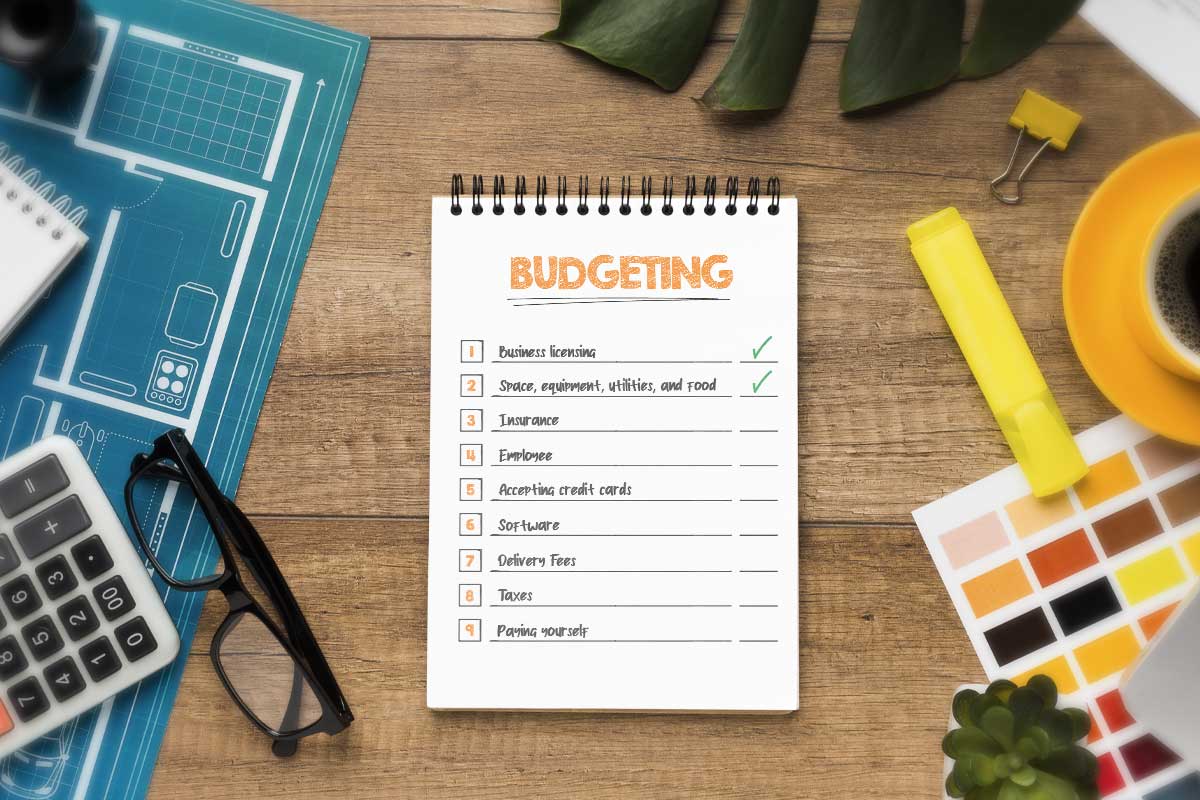 Similar to budgeting in your personal life, creating and maintaining a professional budget is a vital component of starting a successful business. The budget should include:
Similar to budgeting in your personal life, creating and maintaining a professional budget is a vital component of starting a successful business. The budget should include:
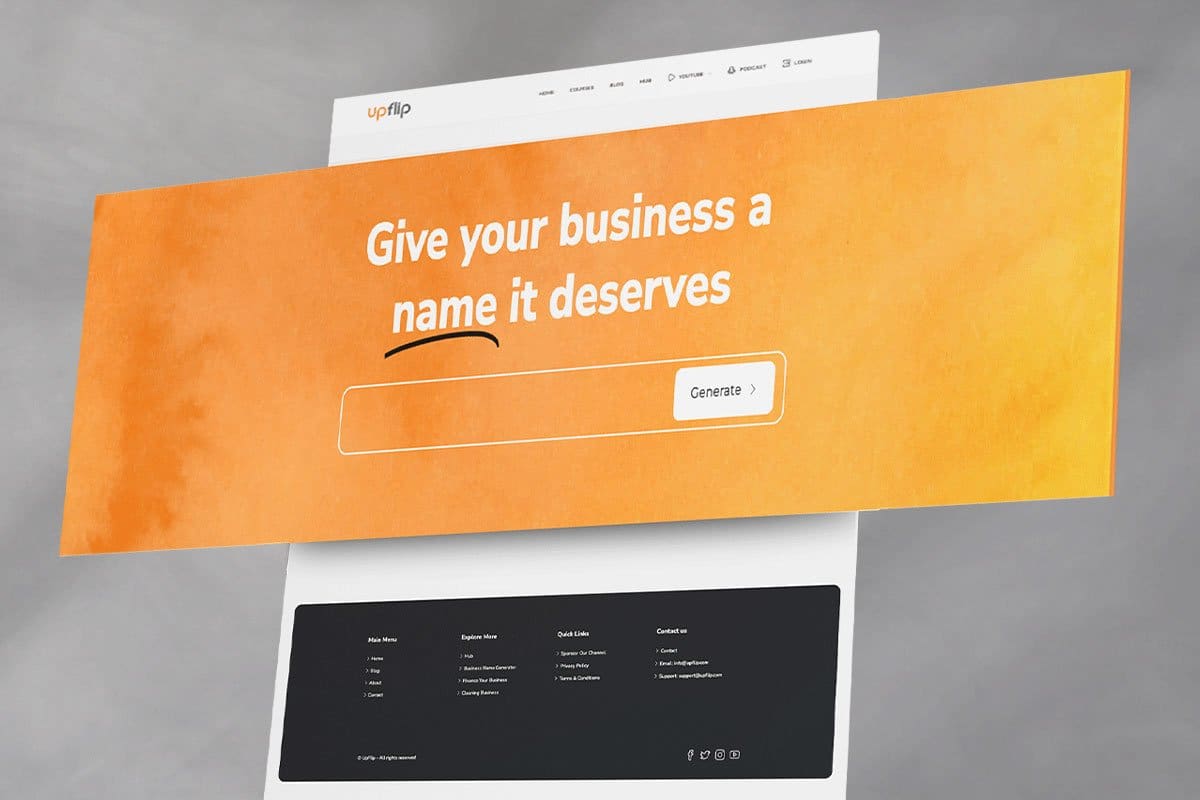 Restaurants choose their names in different ways. Some popular methods include:
Restaurants choose their names in different ways. Some popular methods include:
 You can create a legal structure on your own, but we recommend working with an:
You can create a legal structure on your own, but we recommend working with an:
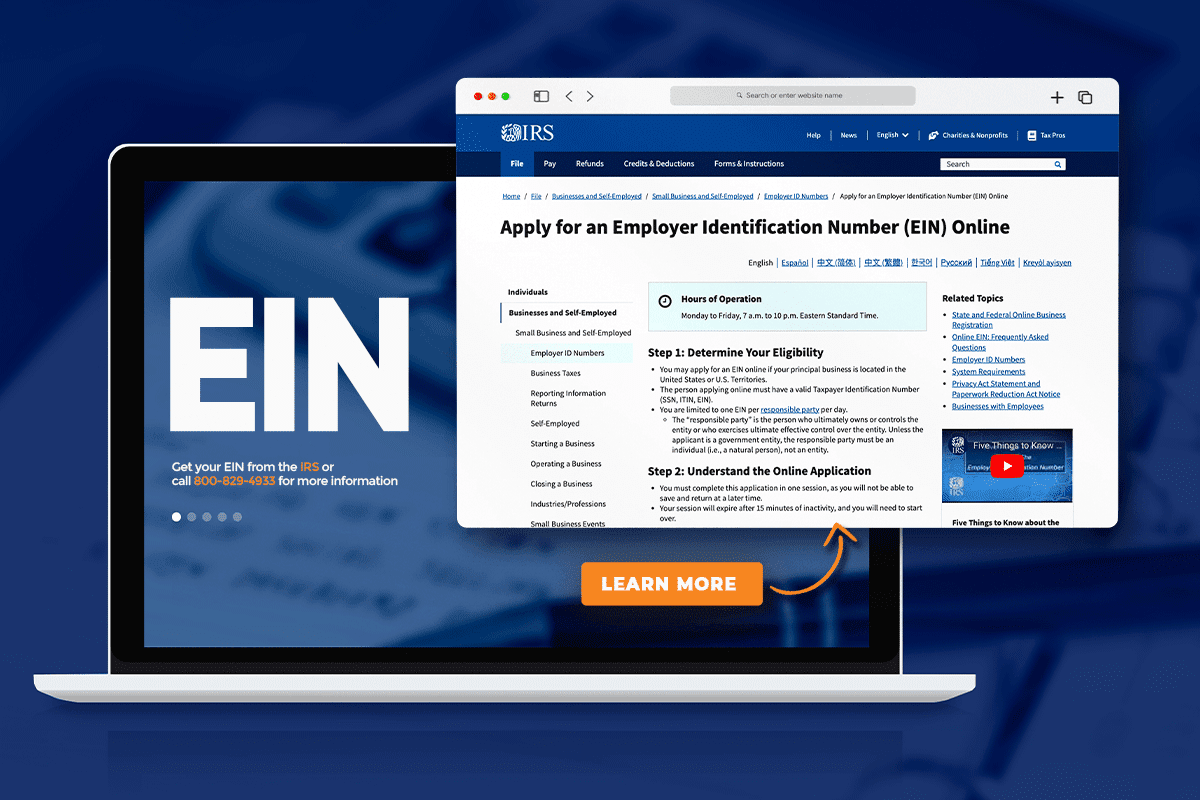 Your restaurant will need an Employee Identification Number (EIN) to hire employees and pay payroll taxes. An EIN is similar to a social security number for your business. You’ll need it to:
Your restaurant will need an Employee Identification Number (EIN) to hire employees and pay payroll taxes. An EIN is similar to a social security number for your business. You’ll need it to:
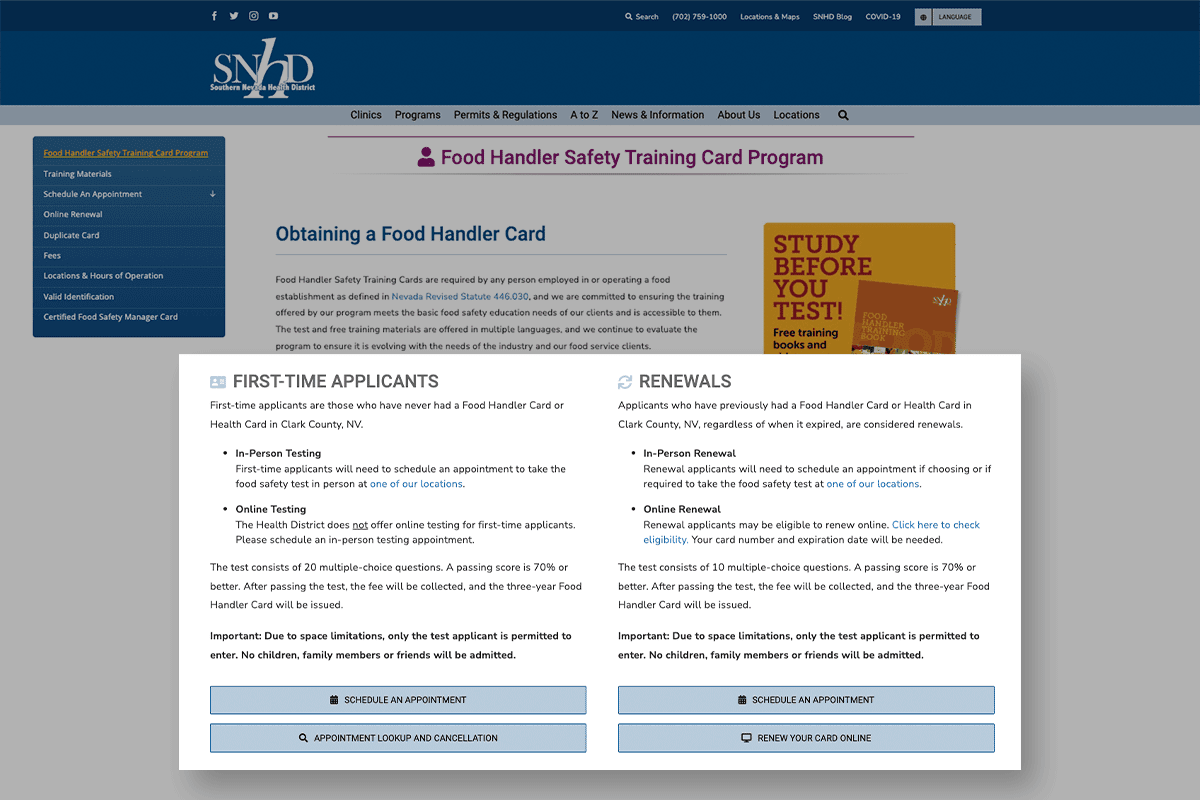 A restaurant requires a health inspection in many locations because they want to make sure you follow food safety regulations. These may also come with other requirements like a training course for the food handlers card in Las Vegas.
A restaurant requires a health inspection in many locations because they want to make sure you follow food safety regulations. These may also come with other requirements like a training course for the food handlers card in Las Vegas.
 Here’s the deal: You will have many things to consider when starting a restaurant, but don’t worry. We’ll show you how to start a restaurant by following these steps:
Here’s the deal: You will have many things to consider when starting a restaurant, but don’t worry. We’ll show you how to start a restaurant by following these steps:
 Huber’s Cafe menu is a high-end cafe that differentiates itself from its competitors based on how they cook their turkeys. James told us:
[su_quote]We use the whole turkey, but we don’t sell the neck as an entree.[/su_quote]
Unlike many upscale restaurants, Huber’s includes pictures in their menu, which I love! (It is so difficult to choose a meal when I can’t picture the presentation.) They picture all their turkey meals, which shows adherence to OpenTable’s first suggestion. They cover all the bases expected with fine dining and 10 items per category. They even make wine suggestions to go with each meal.
The most interesting point on their menu is how prominently they feature their best selling drink.
Huber’s Cafe menu is a high-end cafe that differentiates itself from its competitors based on how they cook their turkeys. James told us:
[su_quote]We use the whole turkey, but we don’t sell the neck as an entree.[/su_quote]
Unlike many upscale restaurants, Huber’s includes pictures in their menu, which I love! (It is so difficult to choose a meal when I can’t picture the presentation.) They picture all their turkey meals, which shows adherence to OpenTable’s first suggestion. They cover all the bases expected with fine dining and 10 items per category. They even make wine suggestions to go with each meal.
The most interesting point on their menu is how prominently they feature their best selling drink.
 Keep reading for more information on starting a restaurant business.
Keep reading for more information on starting a restaurant business.
 Each location will need different equipment and restaurant furniture. Some of the items you’ll need to get for any restaurant include:
Each location will need different equipment and restaurant furniture. Some of the items you’ll need to get for any restaurant include:
 There are three main ways that restaurants price food:
There are three main ways that restaurants price food:
 Before you start operations, you’ll need systems to run it. You’ll need a:
Before you start operations, you’ll need systems to run it. You’ll need a:
 Your restaurant will need to follow state and federal payroll tax laws including requirements to keep a record of employment taxes for at least four years. The IRS tax filing guide is the best source of information for a new business.
Your restaurant will need to follow state and federal payroll tax laws including requirements to keep a record of employment taxes for at least four years. The IRS tax filing guide is the best source of information for a new business.
 Safety is critical to think about when learning how to start restaurant business operations. Restaurants have safety concerns:
Safety is critical to think about when learning how to start restaurant business operations. Restaurants have safety concerns:
 Restaurants have lots of options to help people discover their business. You’ll want to:
Restaurants have lots of options to help people discover their business. You’ll want to:
 Your grand opening is when you introduce yourself to the general public. The goal is to drive attention to your new establishment. You’ll want to contact local media and food influencers to invite them to try your menu. You might also want to post ads on social media and search engines. The goal of the grand opening is to drive attention to your new establishment.
Your grand opening is when you introduce yourself to the general public. The goal is to drive attention to your new establishment. You’ll want to contact local media and food influencers to invite them to try your menu. You might also want to post ads on social media and search engines. The goal of the grand opening is to drive attention to your new establishment.
The routing number (sometimes referred to as an ABA routing number, short for the American Bankers Association) is a sequence of nine digits used by banks to identify specific financial institutions within the U.S. This number proves that the bank is a federal- or state-chartered institution and maintains an account with the Federal Reserve.3 ABA routing numbers were once used with paper checks, and ACH routing numbers were associated with electronic transfers and withdrawals on accounts. However, most banks today use one routing number for all transactions.4 When do I need my routing number? Your account and routing numbers are required for every conceivable banking transaction, whether within the bank where the account is held or between banking institutions. Small banks generally possess just one routing number, while large multinational banks can have several different ones, usually based on the state in which you hold the account. Routing numbers are most commonly required when reordering checks, for payment of consumer bills, to establish a direct deposit (such as a paycheck), or for tax payments. The routing numbers used for domestic and international wire transfers aren't the same as those listed on your checks. However, they can easily be obtained online or by contacting your bank. https://telescope.ac/what-is-check-routing-number-and-where-can-you-find-it/x4xaovog61f3r9lnhjit21
 Inbox
Inbox 
Learn from business failures and successes in 5 min or less. The stories, frameworks, and tactics that will make you a 10x better founder.
 Join our 45,000+ entrepreneurs
Join our 45,000+ entrepreneurs